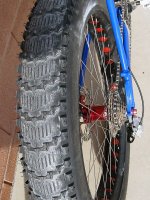Ah, agree completely. I was thinking in the abstract.amberwolf said:I probably should specify "OEM hubmotor wheels" because those are not usually built correctly or with parts that should be used together
If equivalently well-built (extensive caveats agreed upon below), I don't think this is the case.amberwolf said:but even well-built hubmotor wheels can be weaker than the same wheel with a regular-sized hub in it.
Though true, I would clarify that such problems result from larger hub diameter but also smaller rim diameter, or rather the ratio between the two. As the hub-rim ratio increases (larger hub and/or smaller rim), nipple angle limit will eventually be exceeded and the spoke will have to bend/curve/break at the nipple. So it's really more a systems problem, rather than just the hub. (You address this later in your post -- removed to be concise).amberwolf said:And probably should also specify that the larger diameter the hub is, the more the problems tend to stand out; the closer the hub is to the more typical size used, the less the problems tend to crop up.
It may be possible to find a comparison where this is the case (in fact, I built my rear with a front disc hub to maximize flange width), but generally the narrower hubmotor flange width will be offset by the larger flange diameter. It's disappointing that hubmotors are built with narrow flanges and comically-large diameters, rather than wider/taller stators. I'd like to see stator height/width maxed first, before increasing diameter. That's why I recommend the XOFO DD45 or MXUS 3k 45H.amberwolf said:If you look at the angle the spokes are at, when looking at the wheel "edge on" like in the ebikes.ca spoke calculator, you may find a smaller bracing angle for a hubmotor vs a regular bicycle hub. Depends on the specific motor and the specific bike hub and the overall wheel size.
I think we're generally in agreement in this discussion, but this point is most interesting -- I think this is actually an illusion or limitation in the wheel visualization. Offset spoke holes do decrease the measured spoke bracing angle, but not the effective bracing angle. The spoke-nipple-rim assembly is rigid and can be conceived as one piece, so what we care about mechanically is the triangle created by the flanges and a point in the center of the rim.amberwolf said:The wider the spacing of the nipple hole rows is on the rim (like fatbike rims especially), the worse this problem will be--the hubmotor flanges can actually be so close to the rim and so close together that the spokes may actually have to be laced from "drive side" at the hub to "brake side" at the rim in order to get any significant bracing angle.
Lacing to opposite sides is a hack that further exacerbates nipple angle problems.
Well, sure, but there wouldn't be any reason to with modern materials and design. I build my non-ebike wheels as 16/20. As we noted above, 36-spoke hubmotors are an artifact of poor hub/wheel design, materials, and assembly. Premium 32-spoke hubmotors are a known improvement.amberwolf said:As for more spokes on hubmotor wheels, that's not necessarily true. There are plenty of bicycles using 36-spoke wheels. Almost every one I have ever owned, which is more than I can remember, have been 36-spoke wheels. A few wheels I've had and used (not on the bikes they came from :lol: ) were 48 spoke, and only one bike I have uses wheels with less than 36 (I think it's 32, but I can't remember ATM). All of those I listed are plain bicycle wheels. Many hubmotors use 36 spokes, but some do use less, or more.
Yep, great caveats. Just differences in abstract/theoretical design vs practical application.amberwolf said:Also, just having thicker spokes is not better. The wheel must have the correct rim for those thicker spokes, or they cannot be tensioned correctly and the wheel then develops problems with nipples loosening and/or spokes breaking at the elbow. If they are tensioned correctly and the rim isn't strong enough for that, then the rim will crack or deform at the nipple holes, and then the tension is lost and the other problems can develop (or worse). I've had all of those problems (even on my "normal" ebikes :lol: ) with various OEM hubmotor wheels using too-thick spokes for the rims they're built with. There's pics in some of my build and other threads showing some of the cracked-nipple-hole rims, broken nipples, broken spokes, etc., if you're curious.
If you use rims capable of handling the tension of a thicker spoke, then you can make even stronger wheels with those...but that's not typically how hubmotor wheels get built.For some reason a lot of people get it into their head that thicker is *always* better, but don't know how the wheel itself "works", and end up with wheels that fall apart because of damaged rims from too high a tension on their nipple holes.


